Monitoring the Spatiotemporal Difference in Glacier Elevation on Bogda Mountain from 2000 to 2017
Abstract
1. Introduction
2. Data and Methods
2.1. Study Area
2.2. Data
2.3. Methods
2.3.1. Using the ROI Method to Generate a DEM
2.3.2. Establishment of Logarithmic Fitting Model (LFM)
3. Results
3.1. Threshold Analysis of Glacier Elevation Variation
3.2. LFM Results
3.3. Meteorological Data Processing Results
4. Discussion
4.1. Effects of Glacier Area on Glacier Elevation
4.2. Effects of Glacier Aspect on Glacier Elevation
4.3. Effects of Glacier Altitude on Glacier Elevation
4.4. Effect of Lakes on Glacier Elevation
4.5. Effects of Meteorological Factors on Glacier Elevation
5. Conclusions
Author Contributions
Funding
Institutional Review Board Statement
Informed Consent Statement
Data Availability Statement
Acknowledgments
Conflicts of Interest
References
- Du, W.B.; Li, J.L.; Bao, A.M.; Wang, B.S. Mapping changes in the glaciers of the eastern Tienshan Mountains during 1977–2013 using multitemporal remote sensing. J. Appl. Remote Sens. 2014, 8, 084683. [Google Scholar] [CrossRef]
- Rossman, N.R.; Zlotnik, V.A.; Rowe, C.M.; Szilagyi, J. Vadose zone lag time and potential 21st century climate change effects on spatially distributed groundwater recharge in the semi-arid Nebraska Sand Hills. J. Hydrol. 2014, 519, 656–669. [Google Scholar] [CrossRef]
- Yang, X.H.; Zhao, J.D.; Han, H. Mass balance of glaciers in the Harlik mountain area of Eastern Tianshan Mountains from 1972 to 2016. J. Glaciol. Geocryol. 2019, 41, 1–11. [Google Scholar]
- Hoelzle, M.; Azisov, E.; Barandun, M.; Huss, M.; Zemp, M. Re-establishing glacier monitoring in Kyrgyzstan and Uzbekistan, Central Asia. Geosci. Instrum. Methods Data Syst. Discuss. 2017, 6, 397–418. [Google Scholar] [CrossRef]
- Qin, Y.; Yang, T.B.; Ji, Q.; Wang, J. Analysis of modern glacier change in Harlik mountain from 1973 to 2016. J. LanZhou Univ. 2018, 54, 569–576. [Google Scholar]
- Wang, N.L.; Yao, T.D.; Xu, B.Q.; Chen, A.A.; Wang, W.C. Temporal and spatial patterns, trends and impacts of glacier changes in the Tibetan Plateau and its surrounding areas under global warming. Chin. Acad. Sci. 2019, 64, 2865–2875. [Google Scholar]
- Kulshrestha, A.; Bahuguna, I.M.; Rathore, B.P.; Iyer, K.V. Resolving Biases in DEM Differencing for Estimation of Change in Elevation of Glacier Surfaces Using Cartosat-I Stereo Data. J. Indian Soc. Remote Sens. 2020, 48, 1443–1453. [Google Scholar] [CrossRef]
- Patel, A.; Prajapati, R.; Dharpure, J.K.; Mani, S.; Chauhan, D. Mapping and monitoring of glacier areal changes using multispectral and elevation data: A case study over Chhota-Shigri glacier. Earth. Sci. Inf. 2019, 12, 489–499. [Google Scholar] [CrossRef]
- Wang, Y.; Hou, S.; Liu, Y. Glacier changes in the Karlik Shan, eastern Tien Shan, during 1971/72–2001/02. Ann. Glaciol. 2009, 50, 39–45. [Google Scholar] [CrossRef]
- Du, W.; Ji, W.; Xu, L.; Wang, S. Deformation time series and driving-force analysis of glaciers in the Eastern Tienshan Mountains using the SBAS InSAR method. Int. J. Environ. Res. Public Health 2020, 17, 2836. [Google Scholar] [CrossRef]
- Minallah, N.; Khan, W. Comparison of neural networks and support vector machines for the mass balance ablation observation of glaciers in Baltoro region. J. Inf. Commun. Technol. Robot. Appl. 2019, 9, 37–45. [Google Scholar]
- Prudnikova, T.N. The Tarim Basin and the transformation of its landscapes. Arid. Ecosyst. 2019, 9, 157–165. [Google Scholar] [CrossRef]
- Moholdt, G.; Nuth, C.; Hagen, J.O.; Kohler, J. Recent elevation changes of Svalbard glaciers derived from ICESat laser altimetry. Remote Sens. Environ. 2010, 114, 2756–2767. [Google Scholar] [CrossRef]
- Nuth, C.; Moholdt, G.; Kohler, J.; Hagen, J.O.; Kääb, A. Svalbard glacier elevation changes and contribution to sea level rise. J. Geophys. Res. Earth Surf. 2010, 115. [Google Scholar] [CrossRef]
- Farinotti, D.; Longuevergne, L.; Moholdt, G.; Duethmann, D.; Mölg, T.; Bolch, T.; Vorogushyn, S.; Güntner, A. Substantial glacier mass loss in the Tien Shan over the past 50 years. Nat. Geosci. 2015, 8, 716–722. [Google Scholar] [CrossRef]
- Chao, N.F.; Chen, G.; Wang, Z.T. Impact of Eastern Tibetan Plateau Glacier melt on land water storage change across the Yangtze river basin. J. Hydrol. Eng. 2020, 25, 05020002. [Google Scholar] [CrossRef]
- Kaab, A.; Berthier, E.; Nuth, C.; Gardelle, J.; Arnaud, Y. Contrasting patterns of early twenty-first-century glacier mass change in the Himalayas. Nature 2012, 488, 419, 495–498. [Google Scholar] [CrossRef]
- Parrella, G.; Hajnsek, I. TanDEM-X dual-polarization time series for the estimation of snow accumulation on an alpine glacier. In Proceedings of the TerraSAR-X/TanDEM-X Science Team Meeting 2019, Oberpfaffenhofen, Germany, 21–24 October 2019. [Google Scholar]
- Strozzi, T.; Caduff, R.; Jones, N.; Barboux, C.; Delaloye, R.; Bodin, X.; Kaab, A.; Matzler, E.; Schrott, L. Monitoring rock glacier kinematics with satellite synthetic aperture radar. Remote Sens. 2020, 12, 559. [Google Scholar] [CrossRef]
- Huss, M.; Farinotti, D. Distributed ice thickness and volume of all glaciers around the globe. J. Geophys. Res. Earth Surf. 2012, 117. [Google Scholar] [CrossRef]
- Huang, T.; Li, J.; Menenti, M.; Jing, L.; Hu, G. A new method to estimate changes in glacier surface elevation based on polynomial fitting of sparse ICESat—GLAS footprints. Sensors 2017, 17, 1803. [Google Scholar] [CrossRef]
- Zhang, X.Y.; Edwards, R. Anthropogenic sulfate and nitrate signals in snow from Bogda Glacier, Eastern Tianshan. J. Earth Sci. 2011, 22, 490–502. [Google Scholar] [CrossRef]
- Li, B.L.; Zhu, A.X.; Zhang, Y.C.; Pei, T.; Qin, C.Z.; Zhou, C.H. Glacier change over the past four decades in the middle Chinese Tien Shan. J. Glaciol. 2006, 52, 425–432. [Google Scholar] [CrossRef]
- Wang, P.Y.; Li, Z.Q.; Li, H.L.; Cao, M.; Wang, W.B.; Wang, F.T. Glacier No. 4 of Sigong River over Mt. Bogda of eastern Tianshan, central Asia: Thinning and retreat during the period 1962–2009. Environ. Earth Sci. 2012, 66, 265–273. [Google Scholar] [CrossRef]
- Guo, W.Q.; Liu, S.Y.; Xu, L.; Wu, L.Z.; Shangguan, D.H.; Yao, X.J.; Wei, J.F.; Bao, W.J.; Yu, P.C.; Liu, Q.; et al. The second Chinese glacier inventory: Data, methods and results. J. Glaciol. 2015, 61, 357–372. [Google Scholar] [CrossRef]
- Shen, Y.P.; Wang, G.Y.; Ding, Y.J.; Su, H.C.; Mao, W.F.; Wang, S.D.; Mamatkanov, D.M. Changes in Merzbacher Lake of Inylchek Glacier and glacial flash floods in Aksu River Basin, Tianshan during the period of 1903–2009. J. Glaciol. Geocryol. 2009, 31, 993–1002. [Google Scholar]
- Li, K.M.; Li, H.L.; Wang, L.; Gao, W.Y. On the Relationship between Local Topography and Small Glacier Change under Climatic Warming on Mt. Bogda, Eastern Tian Shan, China. J. Earth Sci. 2011, 22, 515–527. [Google Scholar]
- Scheuchl, B.; Mouginot, J.; Rignot, E.; Morlighem, M.; Khazendar, A. Grounding line retreat of Pope, Smith, and Kohler Glaciers, West Antarctica, measured with Sentinel-1a radar interferometry data. Geophys. Res. Lett. 2016, 43, 8572–8579. [Google Scholar] [CrossRef]
- Sanchez-Gamez, P.; Navarro, F.J. Glacier surface velocity retrieval using D-InSAR and offset tracking techniques applied to ascending and descending passes of Sentinel-1 data for Southern Ellesmere Ice Caps, Canadian Arctic. Remote Sens. 2017, 9, 442. [Google Scholar] [CrossRef]
- Surazakov, A.B.; Aizen, V.B. Estimating volume change of mountain glaciers using SRTM and map-based topographic data. IEEE Trans. Geosci. Remote Sens. 2006, 44, 2991–2995. [Google Scholar] [CrossRef]
- Ye, Q.H.; Zong, J.B.; Tian, L.D.; Cogley, J.G.; Song, C.Q.; Guo, W.Q. Glacier changes on the Tibetan Plateau derived from Landsat imagery: Mid-1970s-2000-13. J. Glaciol. 2017, 63, 273–287. [Google Scholar] [CrossRef]
- Nicolas, J.-M.; Vasile, G.; Gay, M.; Tupin, F.; Trouve, E. SAR processing in the temporal domain: Application to direct interferogram generation and mountain glacier monitoring. Can. J. Remote. Sens. 2007, 33, 52–59. [Google Scholar] [CrossRef][Green Version]
- Wang, X.W.; Liu, L.; Zhao, L.; Wu, T.H.; Li, Z.Q.; Liu, G.X. Mapping and inventorying active rock glaciers in the northern Tien Shan of China using satellite SAR interferometry. Cryosphere 2017, 11, 997–1014. [Google Scholar] [CrossRef]
- Martone, M.; Braeutigam, B.; Rizzoli, P.; Gonzalez, C.; Bachmann, M.; Krieger, G. Coherence evaluation of TanDEM-X interferometric data. ISPRS J. Photogramm. 2012, 73, 21–29. [Google Scholar] [CrossRef]
- Li, J.L.; Sheng, Y.W. An automated scheme for glacial lake dynamics mapping using Landsat imagery and digital elevation models: A case study in the Himalayas. Int. J. Remote Sens. 2012, 33, 5194–5213. [Google Scholar] [CrossRef]
- Zhang, G.Q.; Li, J.L.; Zheng, G.X. Lake-area mapping in the Tibetan Plateau: An evaluation of data and methods. Int. J. Remote Sens. 2017, 38, 742–772. [Google Scholar] [CrossRef]
- Wang, D.; Kaab, A. Modeling Glacier Elevation Change from DEM Time Series. Remote Sens. 2015, 7, 10117–10142. [Google Scholar] [CrossRef]
- Fattahi, H.; Amelung, F. DEM Error Correction in InSAR Time Series. IEEE Trans. Geosci. Remote Sens. 2013, 51, 4249–4259. [Google Scholar] [CrossRef]
- Wang, P.Y.; Li, Z.Q.; Wang, W.B.; Li, H.L.; Wang, F.T. Glacier volume calculation from ice-thickness data for mountain glaciers—A case study of Glacier No. 4 of Sigong River over Mt. Bogda, Eastern Tianshan, Central Asia. J. Earth Sci. 2014, 25, 371–378. [Google Scholar] [CrossRef]
- Fistook, J.L.; Head, J.W.; Marchant, D.R.; Forget, F. Tropical mountain glaciers on Mars: Altitude-dependence of ice accumulation, accumulation conditions, formation times, glacier dynamics, and implications for planetary spin-axis/orbital history. Icarus 2008, 198, 305–317. [Google Scholar] [CrossRef]
- Wang, P.Y.; Li, Z.Q.; Wang, W.B.; Li, H.L.; Wu, L.Z.; Huai, B.J.; Zhou, P.; Jin, S.; Wang, L. Comparison of changes in glacier area and thickness on the northern and southern slopes of Mt. Bogda, Eastern Tianshan Mountains. J. Appl. Geophys. 2016, 132, 164–173. [Google Scholar] [CrossRef]
- Wang, P.Y.; Li, Z.Q.; Huai, B.J.; Wang, W.B.; Li, H.L.; Wang, L. Spatial variability of glacial changes and their effects on water resources in the Chinese Tianshan Mountains during the last five decades. J. Arid Land 2015, 7, 717–727. [Google Scholar] [CrossRef]
- Zhang, M.J.; Wang, S.J.; Li, Z.Q.; Wang, F.T. Analysis of glacier area in China under the background of climate change in the past 50 years. Acta Geogr. Sin. 2011, 66, 1155–1165. [Google Scholar]
- He, Y.; Yang, T.B.; Chen, J.; Huang, Q. Remote sensing monitoring of glacier change in Bogda peak area of the East Tianshan Mountains from 1972 to 2013. Geogr. Sci. 2015, 35, 925–932. [Google Scholar]
- Zhou, Y.G.; Zhao, R.F.; Zhang, L.H.; Zhao, M. Remote sensing monitoring of glacier and snow change and analysis of influencing factors in Bogda peak area. Arid Land Geogr. 2019, 42, 1395–1403. [Google Scholar]
- Wang, H.W.; Huang, C.L.; Hao, X.H.; Zhang, P.; Hou, J.L. Analysis of the influencing factors of the temporal and spatial changes of snow cover in the northern Xinjiang. J. Glaciol. Geocryol. 2014, 36, 508–516. [Google Scholar]
- Yao, Y.B.; Xiao, G.J.; Wang, R.Y.; Zhang, X.Y. Characteristics of climate change in Northwest semi arid region in recent 50 years. Arid Land Geogr. 2009, 32, 159–165. [Google Scholar]
- Lu, A.G.; Kang, S.C.; Pang, D.Q.; Wang, T.M. Study on the asynchrony of temperature change in China under global warming. Arid Land Geogr. 2009, 32, 506–511. [Google Scholar]
- Ye, Z.X.; Chen, Y.N.; Zhang, X.; Mao, X.H.; Luo, J.Y. Analysis of Tarim River cutoff and future hydrological situation. Arid Land Geogr. 2009, 32, 841–849. [Google Scholar]
- Zhang, Q.; Kang, S. Glacier elevation change in the Western Qilian mountains as observed by TerraSAR-X/TanDEM-X images. Geocarto Int. 2019, 36, 1365–1377. [Google Scholar] [CrossRef]
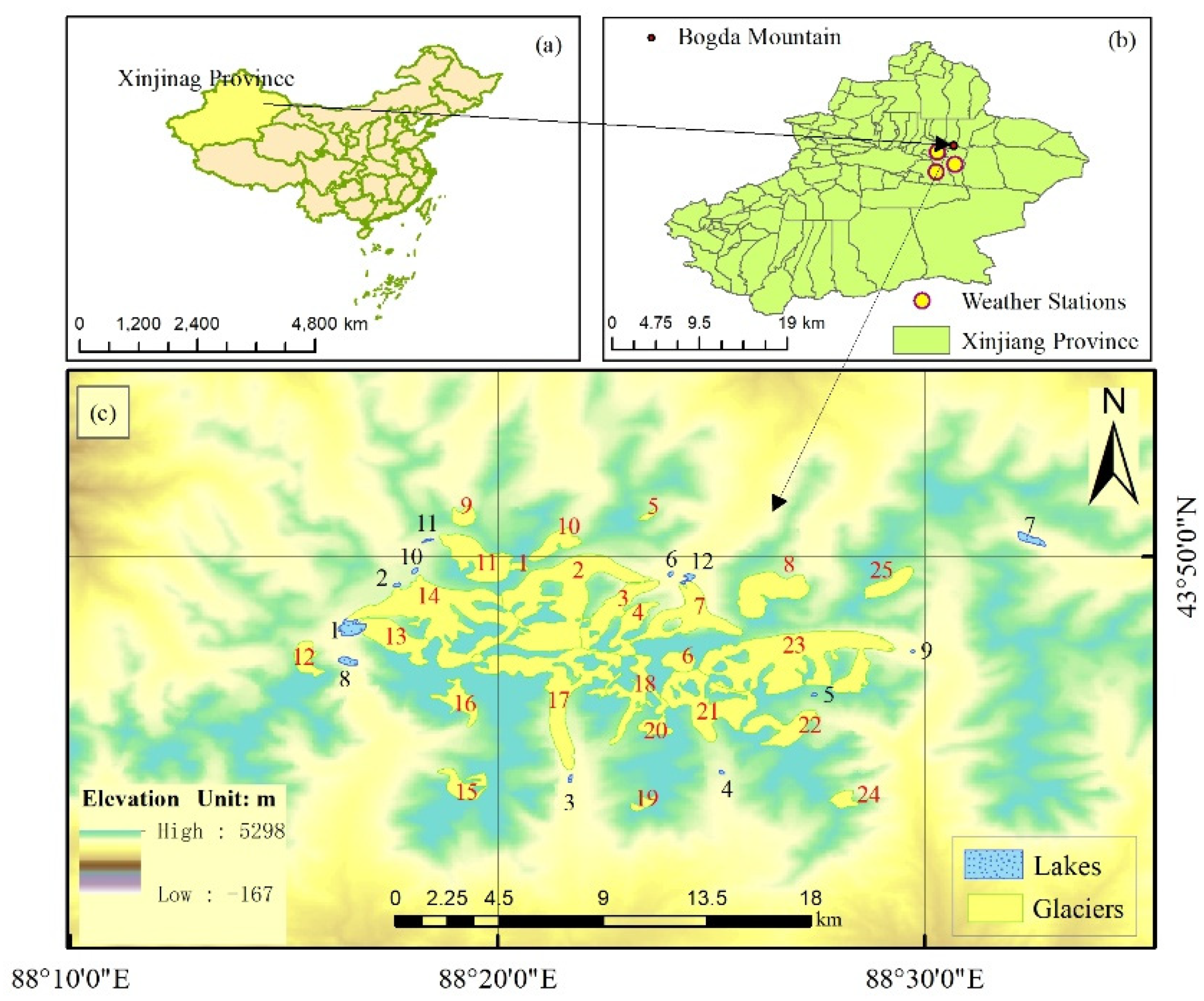


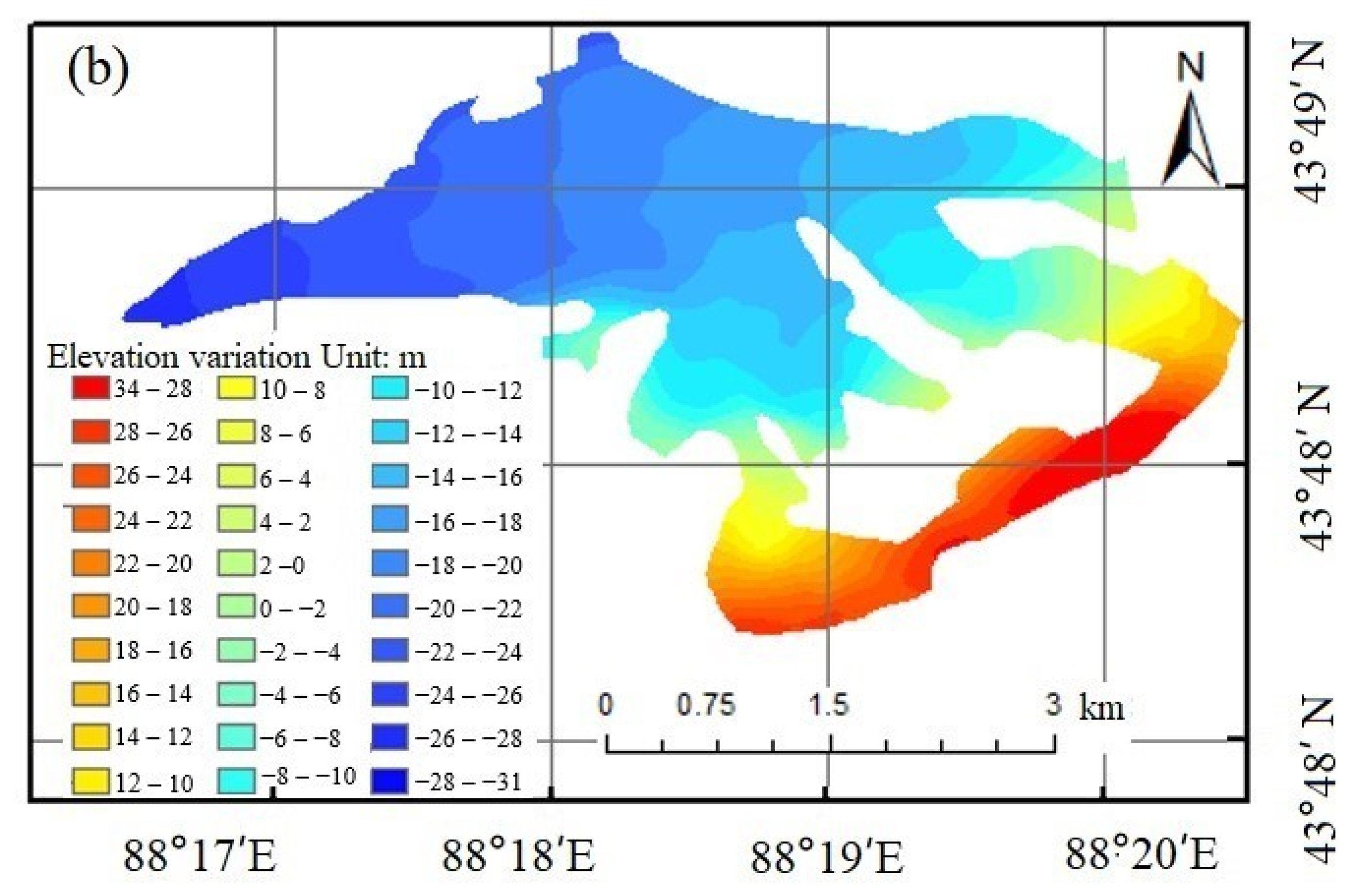
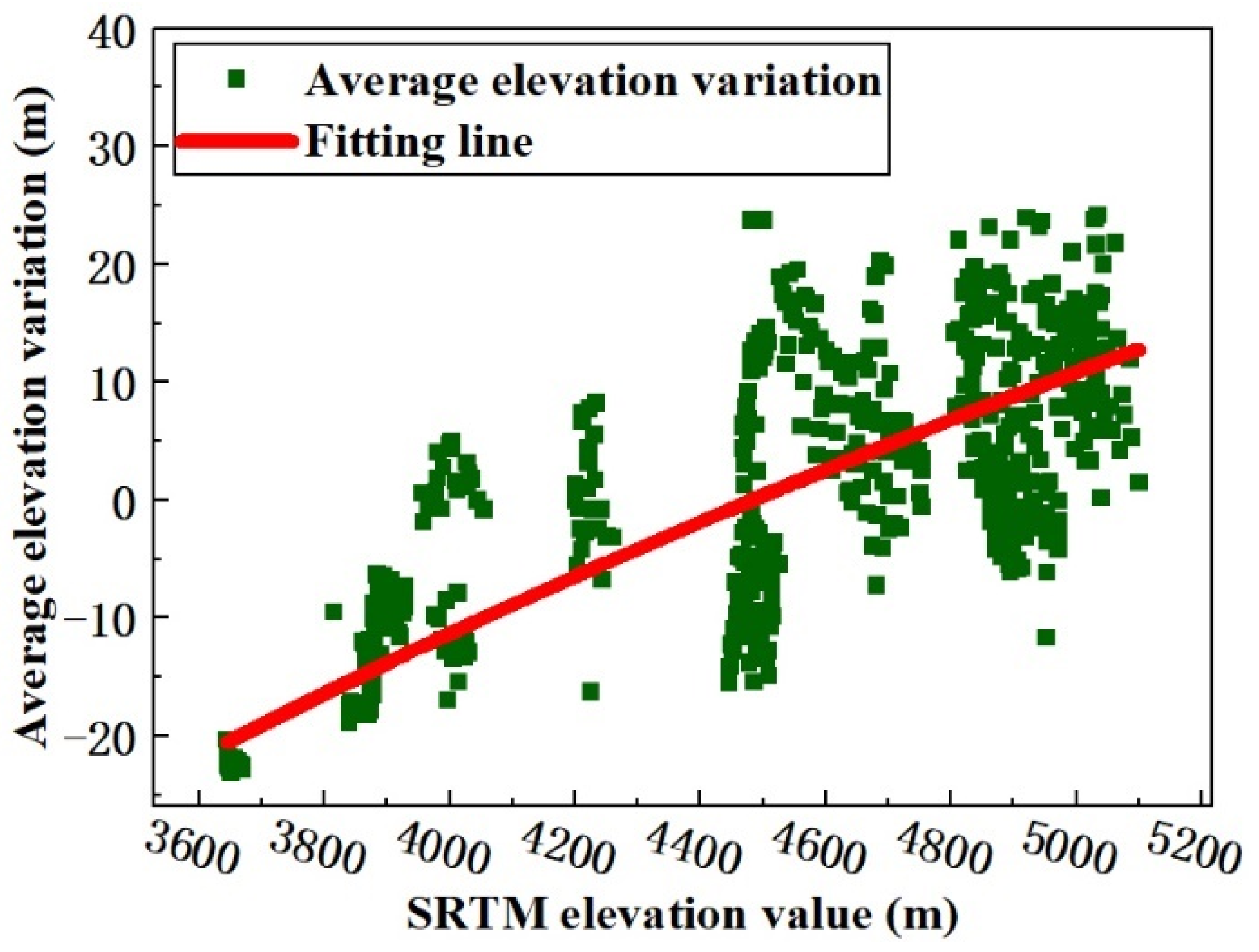

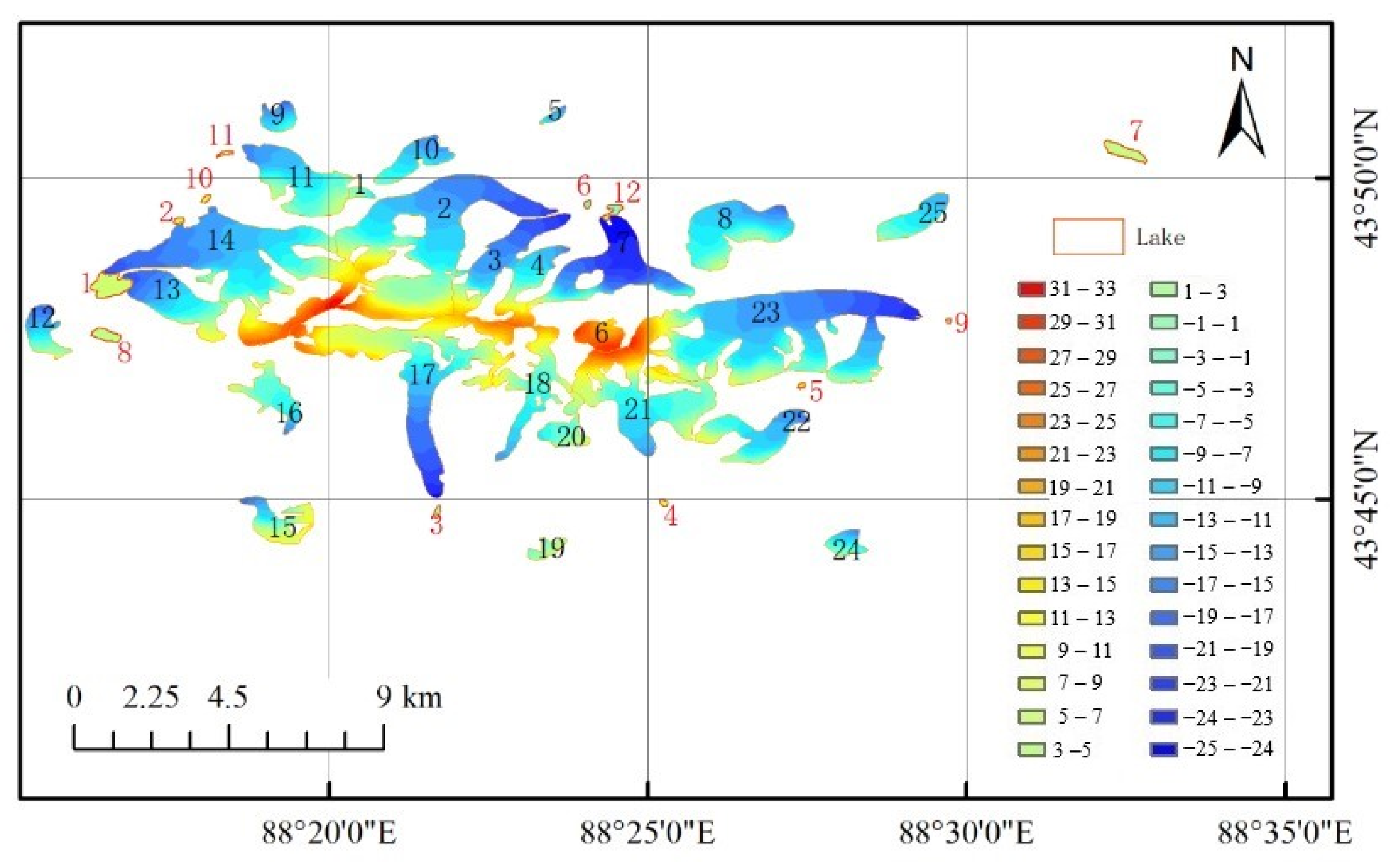
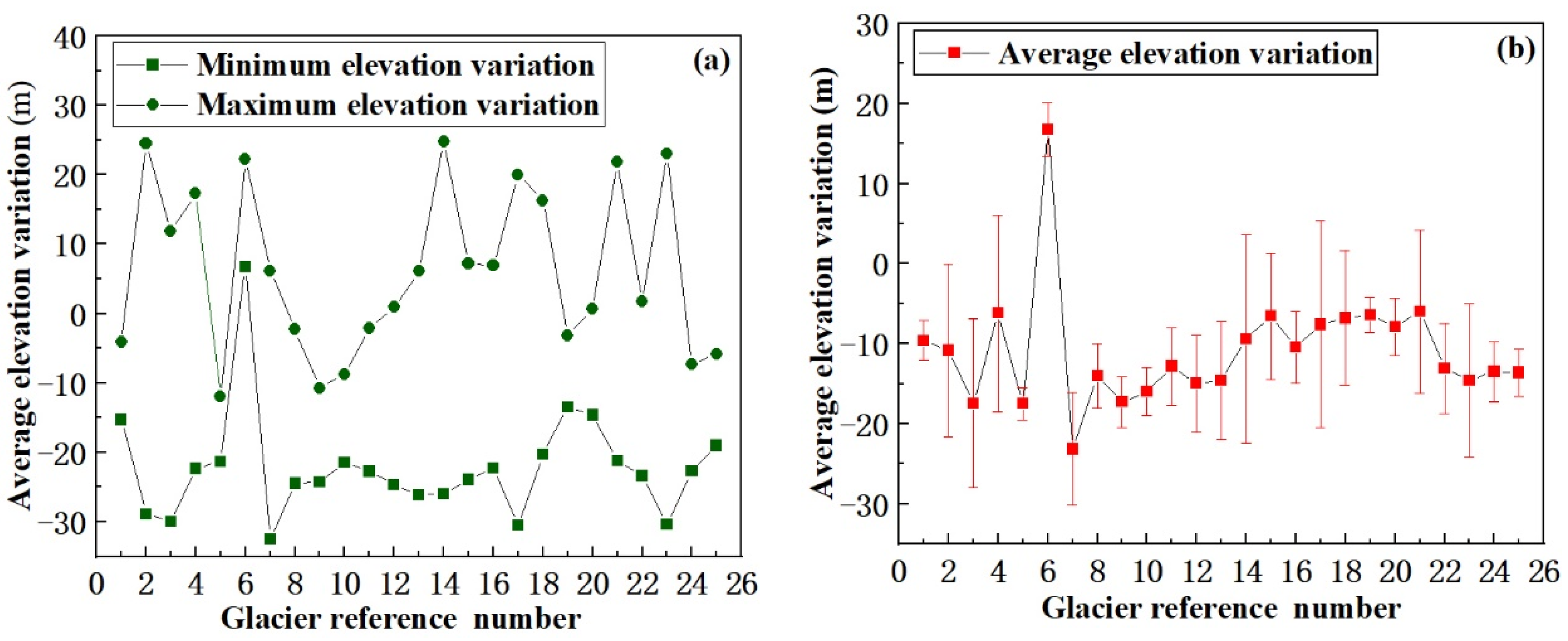

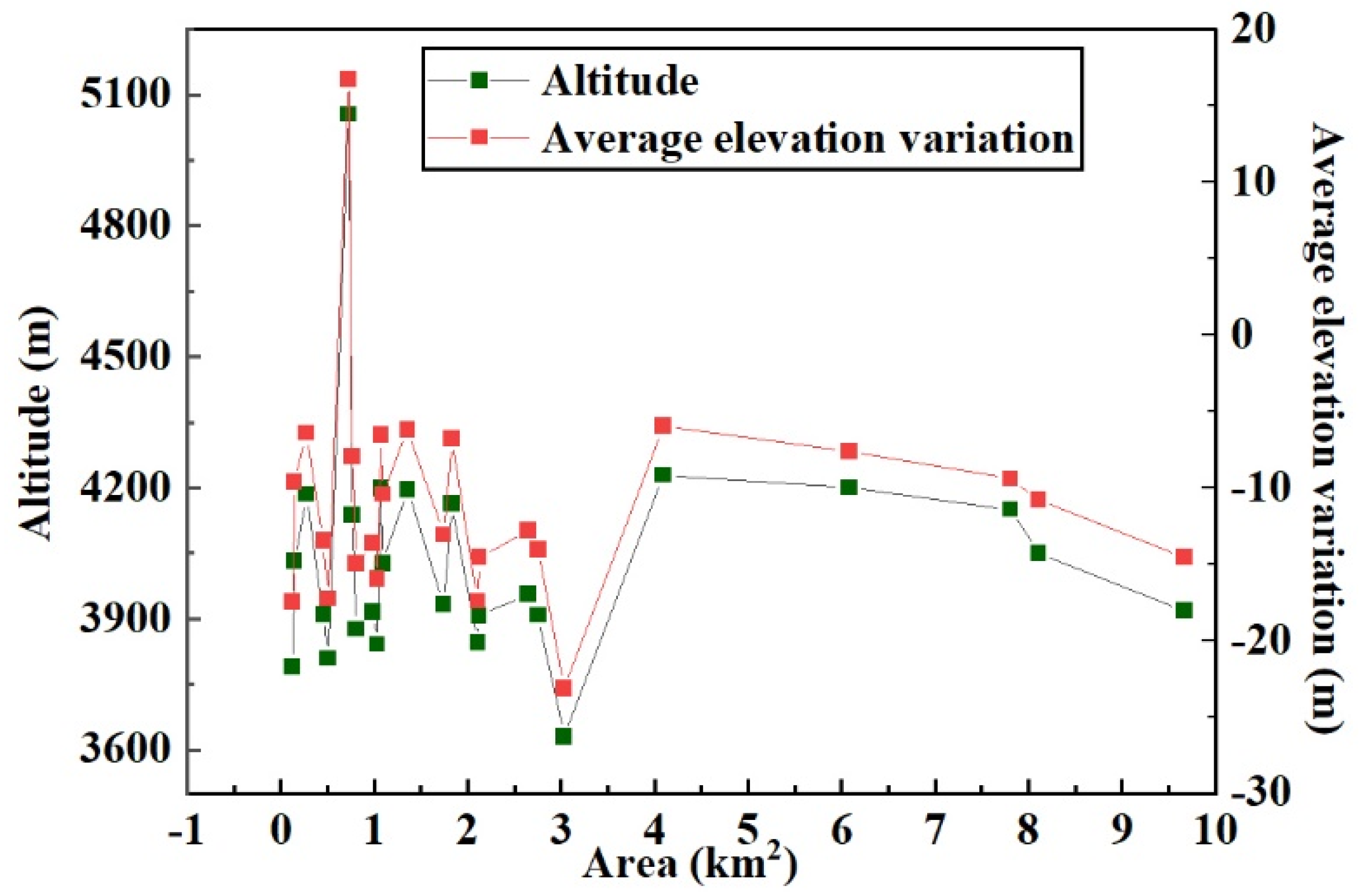
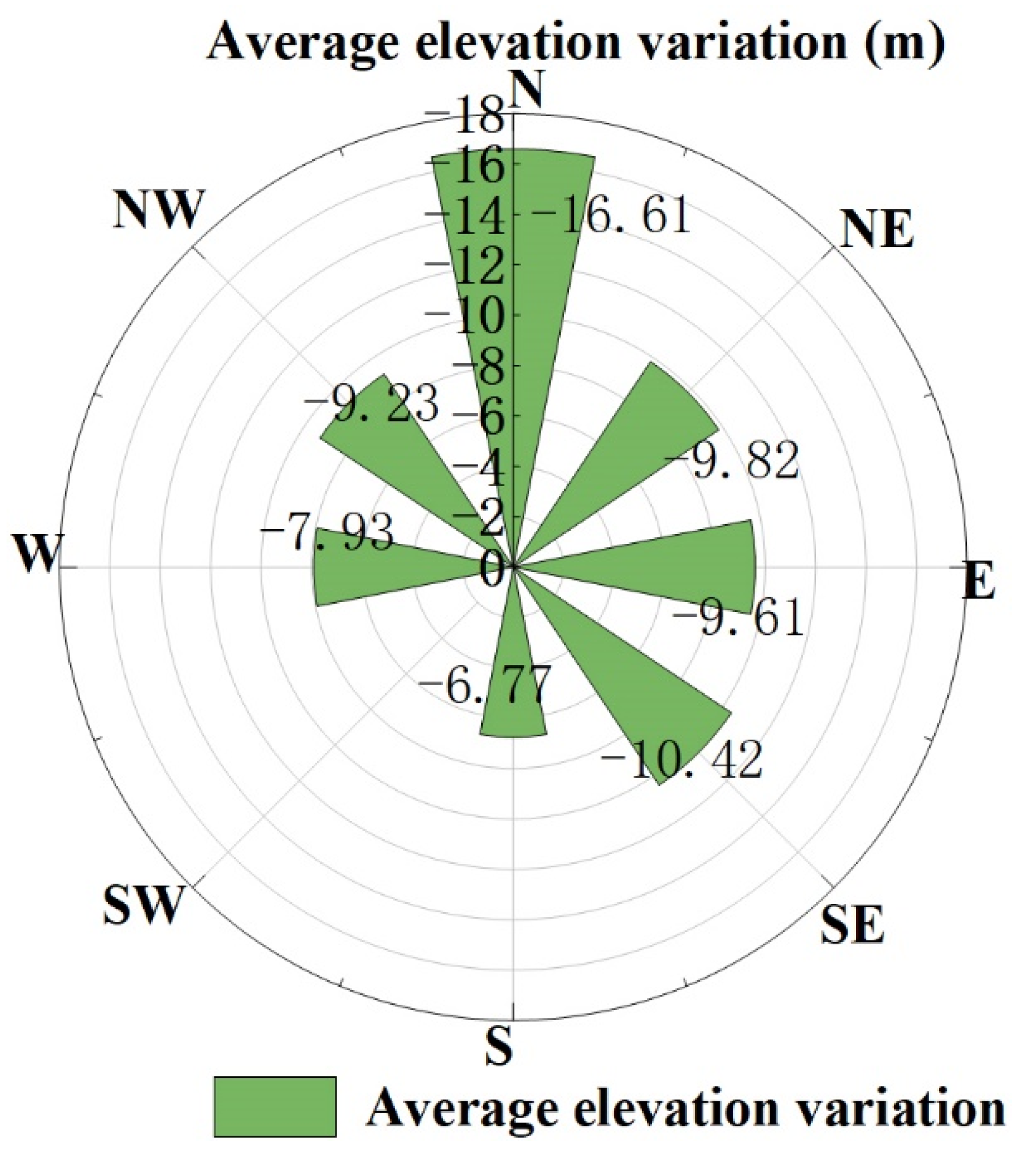
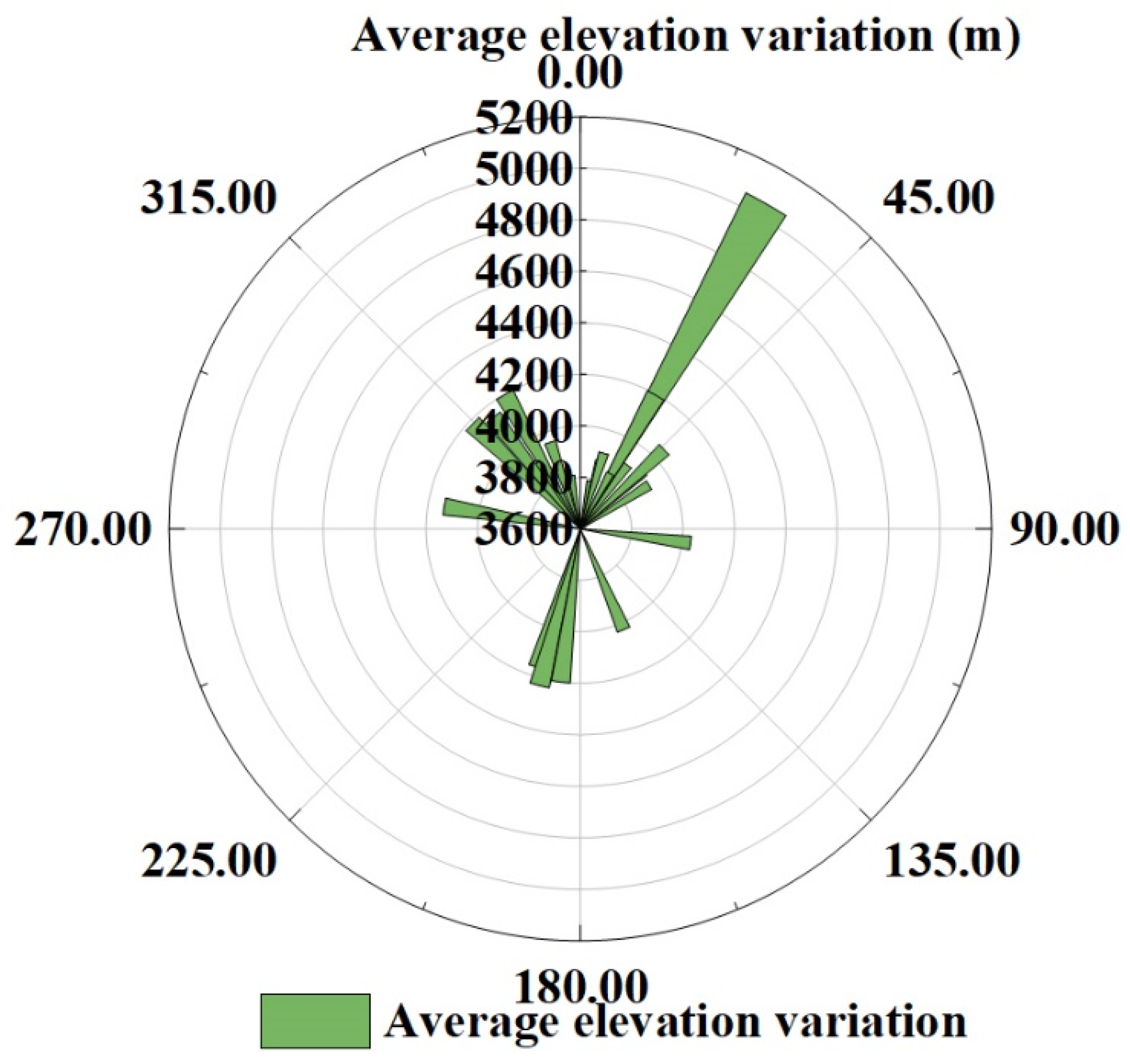
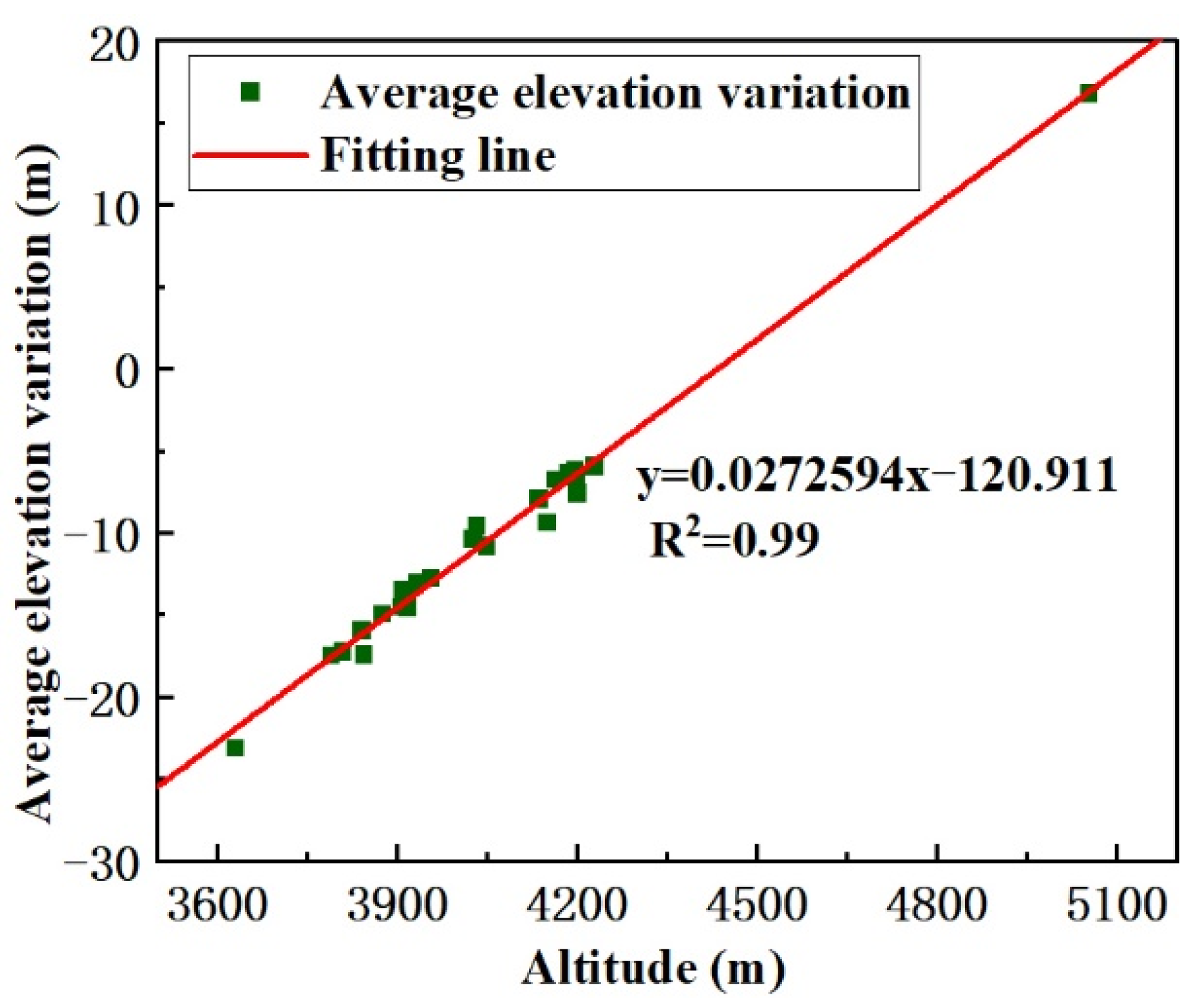
| Glacier No. | Glacier ID | Maximum Elevation (m) | Minimum Elevation (m) | Average Elevation (m) | Average Aspect (°) |
|---|---|---|---|---|---|
| 1 | 5Y725B0010 | 4218.4 | 3846.9 | 4032.7 | 97.3 |
| 2 | 5Y725B0010 | 5393.7 | 3440.6 | 4049.7 | 46.7 |
| 3 | 5Y725B0010 | 5031.3 | 3405.2 | 3844.6 | 28.4 |
| 4 | 5Y725B0009 | 5096.1 | 3636.5 | 4196.7 | 29.5 |
| 5 | 5Y725B0011 | 3939.0 | 3670.6 | 3790.2 | 11.3 |
| 6 | 5Y725B0007 | 5304.5 | 4638.2 | 5055.2 | 29.8 |
| 7 | 5Y725B0008 | 4638.3 | 3344.7 | 3630.1 | 16.3 |
| 8 | 5Y725B0006 | 4319.3 | 3570.7 | 3908.5 | 17.2 |
| 9 | 5Y725C0007 | 4020.7 | 3592.9 | 3809.0 | 350.3 |
| 10 | 5Y725C0003 | 4067.2 | 3663.5 | 3840.9 | 29.2 |
| 11 | 5Y725D0004 | 4323.3 | 3657.4 | 3956.4 | 340.8 |
| 12 | 5Y812B0010 | 4381.9 | 3553.9 | 3875.8 | 16.2 |
| 12 | 5Y812B0011 | 4704.8 | 3548.1 | 3906.8 | 325.7 |
| 14 | 5Y725D0005 | 5428.6 | 3532.6 | 4150.7 | 322.0 |
| 15 | 5Y812B0022 | 4674.5 | 3604.1 | 4199.3 | 330.6 |
| 16 | 5Y812B0015 | 4634.1 | 3667.8 | 4027.3 | 156.7 |
| 17 | 5Y813B0008 | 5208.1 | 3401.4 | 4200.6 | 187.3 |
| 18 | 5Y813B0011 | 4994.0 | 3719.0 | 4164.0 | 197.2 |
| 19 | 5Y813B0015 | 4290.1 | 3955.1 | 4185.8 | 314.2 |
| 20 | 5Y813B0012 | 4421.7 | 3905.1 | 4136.6 | 279.3 |
| 21 | 5Y813B0017 | 5293.8 | 3684.4 | 4229.1 | 194.6 |
| 22 | 5Y813C0006 | 4469.0 | 3600.8 | 3933.5 | 47.6 |
| 23 | 5Y813C0010 | 5321.8 | 3400.4 | 3917.7 | 57.5 |
| 24 | 5Y813C0001 | 4140.4 | 3603.2 | 3909.4 | 36.5 |
| 25 | 5Y813C0012 | 4173.2 | 3730.9 | 3916.1 | 47.6 |
| SAR Date | Temporal Baseline | Spatial Baseline | Landsat Image Date | Sensor | Path/Row |
|---|---|---|---|---|---|
| 29 August 2017 | 12 days | 47.679 m | 2 September 2000 | TM | 142/030 |
| 10 September 2017 | |||||
| 24 August 2018 | 12 days | 100.872 m | 29 September 2017 | OLI | 142/030 |
| 05 September 2018 |
| Glacier No. | Lake No. | Lake Area (m2) | Lake Elevation Variation (m) | Glacier Elevation Variation (m) | SD of Lake Elevation (m) |
|---|---|---|---|---|---|
| 1, 2, 3 | 6 | 41,600 | 7.09 | −14.12 | ±0.5 |
| 7 | 12 | 136,000 | 4.15 | −23.13 | ±0.08 |
| 11 | 11 | 42,000 | 3.26 | −12.80 | ±0.004 |
| 12 | 8 | 248,800 | 15.71 | −14.96 | ±0.9 |
| 17 | 3 | 50,400 | 7.77 | −7.59 | ±0.04 |
| 21 | 4 | 36,400 | 16.32 | −5.95 | ±0.00015 |
| 23 | 5 | 29,200 | 8.08 | −14.56 | ±0.44 |
| 23 | 9 | 18,800 | 14.50 | −14.56 | ±2.30 |
| 14 | 2 | 45,600 | 18 | −9.40 | ±1.40 |
| 14 | 10 | 49,200 | 2.66 | −9.40 | ±0.07 |
| 13 | 1 | 659,600 | 7.56 | −10.81 | ±3.75 |
| 14 | 1 | 659,600 | 7.56 | −17.43 | ±3.75 |
| - | 7 | 380,000 | −6.52 | - | ±0.00042 |
Publisher’s Note: MDPI stays neutral with regard to jurisdictional claims in published maps and institutional affiliations. |
© 2021 by the authors. Licensee MDPI, Basel, Switzerland. This article is an open access article distributed under the terms and conditions of the Creative Commons Attribution (CC BY) license (https://creativecommons.org/licenses/by/4.0/).
Share and Cite
Du, W.; Shi, N.; Xu, L.; Zhang, S.; Ma, D.; Wang, S. Monitoring the Spatiotemporal Difference in Glacier Elevation on Bogda Mountain from 2000 to 2017. Int. J. Environ. Res. Public Health 2021, 18, 6374. https://doi.org/10.3390/ijerph18126374
Du W, Shi N, Xu L, Zhang S, Ma D, Wang S. Monitoring the Spatiotemporal Difference in Glacier Elevation on Bogda Mountain from 2000 to 2017. International Journal of Environmental Research and Public Health. 2021; 18(12):6374. https://doi.org/10.3390/ijerph18126374
Chicago/Turabian StyleDu, Weibing, Ningke Shi, Linjuan Xu, Shiqiong Zhang, Dandan Ma, and Shuangting Wang. 2021. "Monitoring the Spatiotemporal Difference in Glacier Elevation on Bogda Mountain from 2000 to 2017" International Journal of Environmental Research and Public Health 18, no. 12: 6374. https://doi.org/10.3390/ijerph18126374
APA StyleDu, W., Shi, N., Xu, L., Zhang, S., Ma, D., & Wang, S. (2021). Monitoring the Spatiotemporal Difference in Glacier Elevation on Bogda Mountain from 2000 to 2017. International Journal of Environmental Research and Public Health, 18(12), 6374. https://doi.org/10.3390/ijerph18126374







